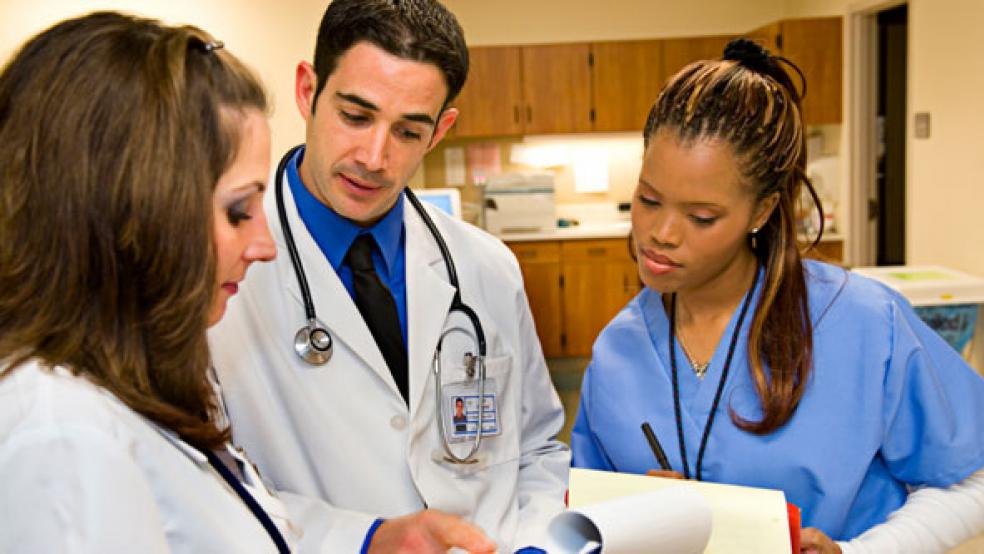Doctors-in-training don’t introduce themselves to hospital patients often enough and rarely sit down to talk eye-to-eye, despite research suggesting that courtesy at the bedside improves both medical recovery and patient satisfaction.
Researchers call for simple adjustments in interns’ bedside manner that could improve patients’ experience in the hospital.
“Basic things make a difference in patient outcomes and they’re not being done to the extent they should be,” says Leonard S. Feldman, assistant professor of medicine at Johns Hopkins University School of Medicine and an associate director of the hospital’s internal medicine residency program. “These are things that matter to patients and are relatively easy to do.”
5 KEYS TO BEDSIDE MANNER
For the new study published online in the Journal of Hospital Medicine, Feldman sent trained observers to spend three weeks following 29 internal medicine interns—doctors in their first year out of medical school—at Johns Hopkins and the University of Maryland Medical Center. They witnessed 732 inpatient “encounters” during 118 intern work shifts.
RELATED: THE REAL REASON FOR THE COMING DOCTOR SHORTAGE
The observers used an iPod Touch app to record whether the interns employed five key strategies known as etiquette-based communication: introducing oneself, explaining one’s role in the patient’s care, touching the patient, asking open-ended questions such as “How are you feeling today?” and sitting down with the patient.
Interns touched their patients (which could be either a physical exam or just a handshake or a gentle, caring touch) during 65 percent of visits and asked open-ended questions 75 percent of the time. But they introduced themselves only 40 percent of the time, explained their role only 37 percent of the time, and sat down during only 9 percent of visits.
Worse, Feldman says, new doctors performed all five of the recommended behaviors during just four percent of all patient encounters. They were only slightly more likely to introduce themselves to patients during their first encounter than during a later one.
GETTING TO KNOW YOU
“Many times when I sit down,” Feldman says, “patients say, ‘Oh my God, is something wrong?’ because I actually bothered to take a seat. People should expect their physicians to sit down with them, to introduce themselves. They shouldn’t be taken aback when they actually do. It’s part of being a doctor.”
Feldman and co-author Lauren Block, a former Johns Hopkins fellow, say one reason trainees may not be following such basic social protocols is that hospitalists, the senior doctors they often learn from, fail to use them. Previous studies have shown that to be the case.
In a follow-up study six months after the observational research was completed, the researchers surveyed nine of the ten Johns Hopkins interns, asking how often they believe they used the five communication strategies.
RELATED: DOCTORS WARN ON 90 OVERUSED MEDICAL TREATMENTS
The interns estimated they introduced themselves to their patients and explained their role 80 percent of the time and that they sat down with patients 58 percent of the time—far more often than they actually did.
“Our perception of ourselves is off a lot of the time, and that’s why it is so important to have data,” notes Block, who says follow-up care also suffers because of lack of good doctor-patient communications.
NO CONNECTION WITH DOCTORS
“It’s no wonder patients don’t feel connected to what we are telling them, because many times we are not doing as much as we could to make that connection,” she says. Other research has shown that only 10 percent of patients can name a doctor who cared for them in the hospital.
The researchers say hospitals and training program officials can take simple steps to improve things, such as providing chairs and photos of the care team in patient rooms. They suggest adding lessons on etiquette-based communication to the curriculum.
Feldman says that when he brings trainees into a patient room on rounds, they all introduce themselves. Even if the patient can’t remember everyone, it creates a better relationship, adding that modeling appropriate behavior for interns is a good place to start.
“The hospital is a dizzying place,” he says. “It’s a new crew all the time—in the emergency room, on the unit, the day team, the night team, the nurses, the respiratory therapist, the pharmacist. By introducing ourselves, we can go a long way toward making the entire hospital experience a little less daunting.”
This article originally appeared at Futurity.org. Source: Johns Hopkins University.





